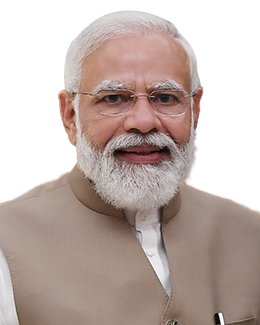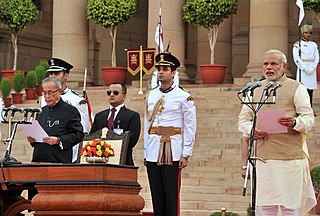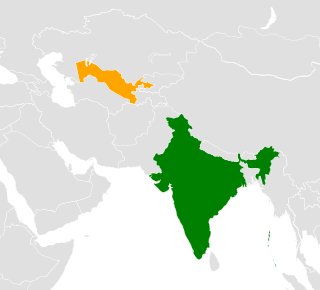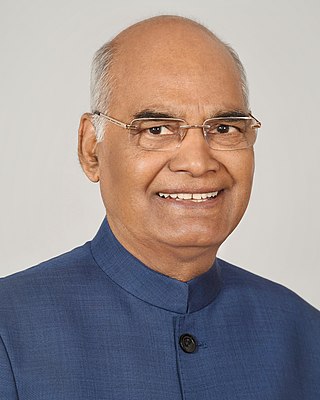
Narendra Damodardas Modi is an Indian politician who has served as the 14th prime minister of India since May 2014. Modi was the chief minister of Gujarat from 2001 to 2014 and is the Member of Parliament (MP) for Varanasi. He is a member of the Bharatiya Janata Party (BJP) and of the Rashtriya Swayamsevak Sangh (RSS), a right wing Hindu nationalist paramilitary volunteer organisation. He is the longest-serving prime minister from outside the Indian National Congress.

Hindus are the third largest Religious group in the United Arab Emirates and constitute around 6.6%-15% of the population in the nation. Hinduism is followed mainly by the significant Nepali and Indian population in the United Arab Emirates.

India–United Arab Emirates relations are the bilateral relations that exist between the Republic of India and the United Arab Emirates. They are both in I2U2 Group. Indians also make up the largest ethnic group in the UAE, making up roughly 38% of UAE's total residents. India is UAE's largest exports destination & trading partner with bilateral trade turnover of US$68.4 billion during the calendar year 2021. UAE's exports to India stood at US$43.04 billion while India's exports to UAE stood at US$25.4 billion. In 2022 India & UAE signed a Comprehensive Economic Partnership Agreement (CEPA) with an aim of taking bilateral trade to US$100 billion within 5 years.

Sultan Ahmed Al Jaber, is an Emirati politician who is the minister of industry and advanced technology of the United Arab Emirates, head of the Abu Dhabi National Oil Company (ADNOC), and chairman of Masdar.

The First Ministry of Narendra Modi is the Council of Ministers headed by Narendra Modi that was formed after the 2014 general election which was held in nine phases from 7 April to 12 May in 2014. The results of the election were announced on 16 May 2014 and this led to the formation of the 16th Lok Sabha. The Council assumed office from 27 May 2014.

The Indian consulate in Herat, Afghanistan was attacked on 23 May 2014 by four heavily armed militants, three days before the inaugural ceremony of Narendra Modi as the Prime Minister of India.

Narendra Modi, parliamentary leader of the Bharatiya Janata Party, started the first tenure of his prime ministership, after his swearing-in as the 14th Prime Minister of India on 26 May 2014. 45 other ministers were also sworn in along with Modi. The ceremony was noted by media for being the first ever swearing-in of an Indian Prime Minister to have been attended by the heads of all SAARC countries.
The foreign policy of the Modi government is associated with the policy initiatives made towards other states by the current government of India after Narendra Modi assumed the office of prime minister on May 26, 2014.

The most significant initiative made by the Narendra Modi government is the focus on neighbouring countries and major Asian powers coupled with emphasizing on the two decades old Look East policy. Asia being the major focus area of his foreign policy, Modi and his foreign minister chose several Asian countries for their initial bilateral visits. He has made state visits to Bhutan and Nepal and Japan within the first 100 days of his government and also hosted Asian leaders like former Prime Minister Tony Abbott of Australia, President Xi Jinping of China and Prime Minister Nguyễn Tấn Dũng of Vietnam, apart from inviting SAARC leaders in his inauguration ceremony. External Affairs Minister Sushma Swaraj has also made official visits to several Asian capitals like Dhaka, Bangladesh, Kathmandu, Nepal, Naypidaw, Myanmar, Singapore, Hanoi, Vietnam, Manama, Bahrain, Kabul, Afghanistan, Dushanbe, Tajikistan, Malé, Maldives, Abu Dhabi, United Arab Emirates, Seoul, South Korea and Beijing China.
The following is a timeline of the Premiership of Narendra Modi from his inauguration as Prime Minister of India on 26 May 2014 till now. The following are the highlights of the major events that took place under his premiership.
The eighteenth summit of 'South Asian Association of Regional Cooperation' (SAARC) was held in Kathmandu, the capital of Federal Democratic Republic of Nepal during 26–27 November 2014. The theme of the summit was Deeper Integration for Peace and Prosperity, focused on enhancing connectivity between the member states for easier transit-transport across the region. Sushil Koirala, the then Nepalese prime minister, was the main host of the event which took place in Rastriya Sabha Griha The summit took place after an interval of three years as the previous summit was held in 2011 in Maldives.
The Middle East region plays a vital role in India's economy as it supplies nearly two-thirds of India's total oil import, bilateral trade is also flourishing in recent years particularly with UAE and other Arab states of the Persian Gulf. Over the years, millions of Indians mostly working class have migrated to the Persian Gulf region looking for jobs and they account for a sizeable share in the total remittances received from abroad. Indian External Affairs Ministry refers the region as West Asia and not as Middle East which is a more popular attribution, particularly in the Western countries.

Neighborhood First Policy of India, a core component of India's foreign policy, focuses on peaceful relations and collaborative synergetic co-development with its South Asian neighbours of the Indian subcontinent encompassing a diverse range of topics, such as economic, technology, research, education, connectivity, space program, defence security, environment, and climate challenge. This policy creates new avenues as well as leverages existing regional cooperation initiatives, such as SAARC, SASEC, BBIN, and BIMSTEC. It compliments India's Look East policy focused on Southeast Asia and Look West Policy focused on Middle East.

India–Uzbekistan relations are the international relations that exist between the Republic of India and the Republic of Uzbekistan. India has an embassy in Tashkent; Uzbekistan has an embassy in New Delhi.

Comoros–India relations are the international relations that exist between Comoros and India. The Embassy of India in Antananarivo, Madagascar is concurrently accredited to Comoros. India also maintains an Honorary Consulate General in Moroni. Comoros maintains an Honorary Consulate in New Delhi.

Equatorial Guinea and India maintain diplomatic relations.

The BAPS Hindu Mandir Abu Dhabi in UAE, is a traditional Hindu place of worship that is being built by the BAPS Swaminarayan Sanstha. The site is located at Abu Mureikhah, which is near Al Rahba off the Dubai–Abu Dhabi Sheikh Zayed Highway. The mandir, upon completion, will be the first traditional Hindu stone mandir in the Middle East. The BAPS Swaminarayan Sanstha, which is headed by Mahant Swami Maharaj, is a denomination of the Swaminarayan branch of Hinduism. The mandir, inspired by Pramukh Swami Maharaj and blessed by Mahant Swami Maharaj, will be situated on 55,000 square meters of land. The mandir will be hand-carved by artisans in India and assembled in the UAE. The mandir will incorporate all aspects and features of a traditional Hindu mandir as part of a fully functional, social, cultural and spiritual complex. The complex will include a visitor center, prayer halls, exhibitions, learning areas, sports area for children, thematic gardens, water features, a food court, a books and gift shop.

The Second Ministry of Narendra Modi is the Council of Ministers headed by Prime Minister of India Narendra Modi that was formed after the 2019 general election which was held in seven phases in 2019. The results of the election were announced on 23 May 2019 and this led to the formation of the 17th Lok Sabha. The swearing-in ceremony was arranged in the courtyards of Rashtrapati Bhavan at Raisina Hill. The heads of the states of BIMSTEC countries were invited as guests of honor for this ceremony.

The presidency of Ram Nath Kovind began on 25 July 2017, when he took the oath as the fourteenth president of India administered by Chief Justice Jagdish Singh Khehar. Kovind was the Bharatiya Janata Party (BJP)-led National Democratic Alliance (NDA) nominee and defeated the Indian National Congress (Congress)-led United Progressive Alliance (UPA) nominee and former speaker of Lok Sabha, Meira Kumar. Prior to being the presidential nominee, he was the governor of Bihar and a member of parliament in Rajya Sabha. Kovind secured approximately two-thirds of the electoral college vote of the elected members of the federal, state and union territory legislatures.
















